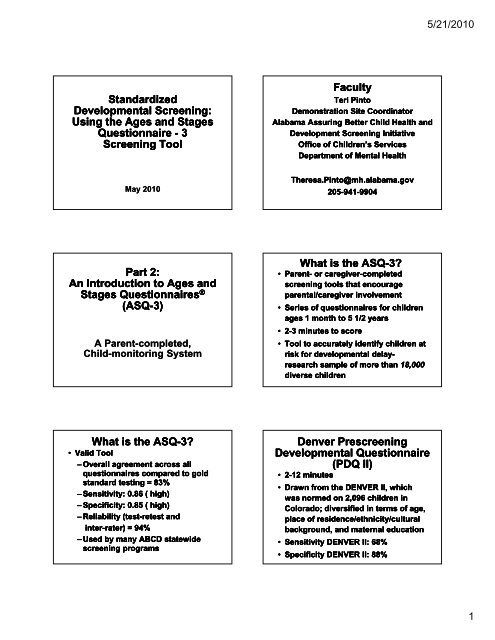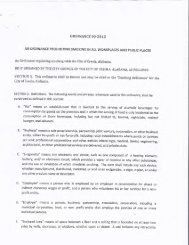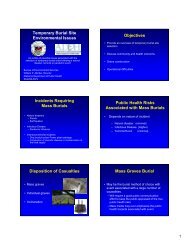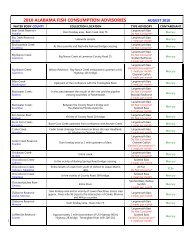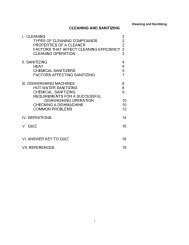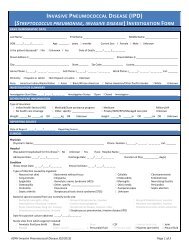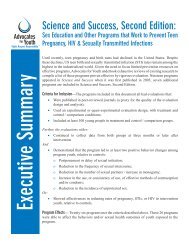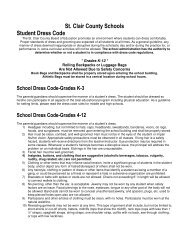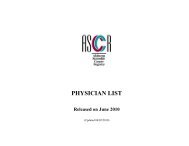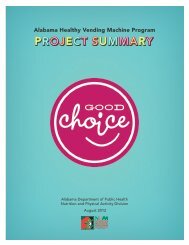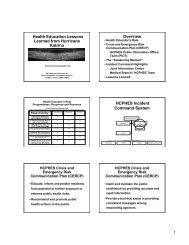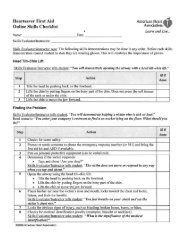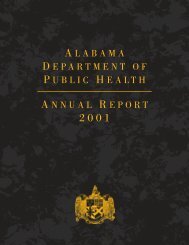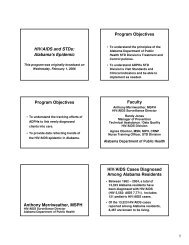Handouts - Alabama Department of Public Health
Handouts - Alabama Department of Public Health
Handouts - Alabama Department of Public Health
Create successful ePaper yourself
Turn your PDF publications into a flip-book with our unique Google optimized e-Paper software.
5/21/2010<br />
Standardized<br />
Developmental Screening:<br />
Using the Ages and Stages<br />
Questionnaire - 3<br />
Screening Tool<br />
Faculty<br />
Teri Pinto<br />
Demonstration Site Coordinator<br />
<strong>Alabama</strong> Assuring Better Child <strong>Health</strong> and<br />
Development Screening Initiative<br />
Office <strong>of</strong> Children’s Services<br />
<strong>Department</strong> <strong>of</strong> Mental <strong>Health</strong><br />
May 2010<br />
Theresa.Pinto@mh.alabama.gov<br />
205-941<br />
941-9904<br />
9904<br />
Part 2:<br />
An Introduction to Ages and<br />
Stages Questionnaires ®<br />
(ASQ<br />
ASQ-3)<br />
A Parent-completed,<br />
Child-monitoring System<br />
What is the ASQ-3?<br />
• Parent- or caregiver-completed<br />
completed<br />
screening tools that encourage<br />
parental/caregiver involvement<br />
• Series <strong>of</strong> questionnaires for children<br />
ages 1 month to 5 1/2 years<br />
• 2-3 minutes to score<br />
• Tool to accurately identify children at<br />
risk for developmental delay-<br />
research sample <strong>of</strong> more than 18,000<br />
diverse children<br />
What is the ASQ-3?<br />
• Valid Tool<br />
– Overall agreement across all<br />
questionnaires compared to gold<br />
standard testing = 83%<br />
– Sensitivity: 0.86 ( high)<br />
– Specificity: 0.85 ( high)<br />
– Reliability (test-retest and<br />
inter-rater) rater) = 94%<br />
– Used by many ABCD statewide<br />
screening programs<br />
Denver Prescreening<br />
Developmental Questionnaire<br />
(PDQ II)<br />
• 2-12<br />
minutes<br />
• Drawn from the DENVER II, which<br />
was normed on 2,096 children in<br />
Colorado; diversified in terms <strong>of</strong> age,<br />
place <strong>of</strong> residence/ethnicity/cultural<br />
background, and maternal education<br />
• Sensitivity DENVER II: 68%<br />
• Specificity DENVER II: 88%<br />
1
5/21/2010<br />
What is the ASQ-3?<br />
• One time purchase - unlimited copies<br />
• Sensitive to Autism, Cerebral Palsy,<br />
ADHD, Developmental Delays<br />
• Highly rated by the American<br />
Academy <strong>of</strong> Pediatrics, the U.S.<br />
<strong>Department</strong> <strong>of</strong> <strong>Health</strong> and Human<br />
Services and First Signs<br />
• No additional screeners needed<br />
What is the ASQ-3?<br />
• Good teaching tool for parents- helps<br />
them learn about child development<br />
and celebrate their own child’s<br />
development<br />
• Strengths based- reveals a child’s<br />
strengths as well as areas <strong>of</strong><br />
concerns so it’s easy to share the<br />
results and develop rapport with<br />
parents<br />
Developmental Domains<br />
Screened by the ASQ-3<br />
• ASQ-3 (screens five domains):<br />
– Communication<br />
– Gross motor<br />
– Fine motor<br />
– Problem solving<br />
– Personal-social<br />
social<br />
ASQ-3 Materials<br />
• The ASQ-3 questionnaires are<br />
available in English, Spanish,<br />
Korean, and French<br />
• Other translations also may be<br />
available<br />
• Contact Brookes Publishing for more<br />
information<br />
ASQ-3 Materials<br />
and Information<br />
• Published by Paul H. Brookes<br />
Publishing Co.<br />
– http://www.brookespublishing.com<br />
– http://www.brookespublishing.com<br />
www.brookespublishing.com/<br />
asqupdates<br />
– http://www.agesandstages.com<br />
Early Detection through<br />
Surveillance and Screening<br />
2
5/21/2010<br />
Surveillance and Screening<br />
• Surveillance is a continuous process<br />
• Screening compliments and<br />
enhances continuous surveillance<br />
What is Surveillance?<br />
• Process <strong>of</strong> recognizing children who<br />
may be at-risk<br />
<strong>of</strong> developmental<br />
delays<br />
• Flexible, longitudinal, continuous<br />
process, in which knowledgeable<br />
pr<strong>of</strong>essionals perform skilled<br />
physical and developmental<br />
observations <strong>of</strong> children within the<br />
context <strong>of</strong> preventive care<br />
What is Screening?<br />
• Brief, objective, and validated test<br />
• Goal is to differentiate children that are<br />
"probably ok" (specificity) vs.<br />
"needing additional investigation“<br />
(sensitivity)<br />
What is Screening?<br />
• Designed to identify children who<br />
should receive more intensive<br />
evaluation or diagnosis from local<br />
Early Intervention (EI), Early Childhood<br />
Special Education (ECSE), health,<br />
and/or mental health agencies<br />
• Performed at a set point in time<br />
Screening<br />
Not near<br />
Beyond cut<strong>of</strong>fs<br />
Near cut<strong>of</strong>fs<br />
cut<strong>of</strong>fs<br />
Pr<strong>of</strong>essional<br />
Continue to monitor<br />
assessment<br />
(re-screen<br />
screen) and use<br />
Prescriptive<br />
Anticipatory<br />
Guidance (activities<br />
Eligible<br />
parents can do at<br />
Not eligible<br />
for<br />
home with their<br />
for services<br />
services<br />
child)<br />
Purposes <strong>of</strong> Screening<br />
• Sorts children into 3 categories<br />
– Needs additional evaluation<br />
• Did not pass screening test<br />
– Needs close monitoring<br />
• Passed screening test but has<br />
risk factors<br />
3
5/21/2010<br />
Purposes <strong>of</strong> Screening<br />
– Needs ongoing monitoring in the<br />
context <strong>of</strong> pre-K, pre-school, child<br />
care or well child checkups<br />
• Passed screening test and has<br />
no known risk factors<br />
Incidence <strong>of</strong> Children Identified<br />
as Having a Disability by Age<br />
• Infants: 2.4%<br />
• Preschool-age: 5.8%<br />
• School-age: 11.6%<br />
• Source: http://www.ideadata.org<br />
2005<br />
Early Identification<br />
and Intervention<br />
• Improved outcomes =<br />
– Higher achievement in math and<br />
reading<br />
– Less antisocial behaviors,<br />
suicidal thoughts/attempts,<br />
smoking, alcohol and THC use…<br />
at 18 years <strong>of</strong> life<br />
McCormick et al, March Pediatrics, 2006<br />
4


